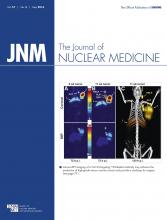Abstract
A spatial bias in brain PET/MR exists compared with PET/CT, because of MR-based attenuation correction. We performed an evaluation among 4 institutions, 3 PET/MR systems, and 4 PET/CT systems using an anthropomorphic brain phantom, hypothesizing that the spatial bias would be minimized with CT-based attenuation correction (CTAC). Methods: The evaluation protocol was similar to the quantification of changes in neurologic PET studies. Regional analysis was conducted on 8 anatomic volumes of interest (VOIs) in gray matter on count-normalized, resolution-matched, coregistered data. On PET/MR systems, CTAC was applied as the reference method for attenuation correction. Results: With CTAC, visual and quantitative differences between PET/MR and PET/CT systems were minimized. Intersystem variation between institutions was +3.42% to −3.29% in all VOIs for PET/CT and +2.15% to −4.50% in all VOIs for PET/MR. PET/MR systems differed by +2.34% to −2.21%, +2.04% to −2.08%, and −1.77% to −5.37% when compared with a PET/CT system at each institution, and these differences were not significant (P ≥ 0.05). Conclusion: Visual and quantitative differences between PET/MR and PET/CT systems can be minimized by an accurate and standardized method of attenuation correction. If a method similar to CTAC can be implemented for brain PET/MRI, there is no reason why PET/MR should not perform as well as PET/CT.
Footnotes
Published online Jan. 28, 2016.
- © 2016 by the Society of Nuclear Medicine and Molecular Imaging, Inc.







